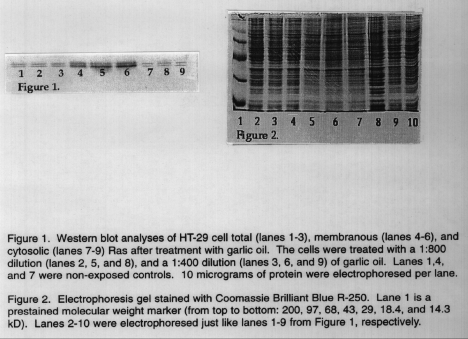Jordan D. Smith and Dr. Byron K. Murray, Microbiology
How does fresh garlic oil affect human colon cancer cells? HT-29 is a cell line of human colon cancer originally extracted from a primary tumor in 1964. 3-hydroxy-3- methylglutaryi-CoA reductase (HGMR) is an enzyme responsible for attaching a lipid group to the 21 kilodalton (kD) Ras protein (p2l Ras), a molecule involved in cell signaling. This attachment is essential for the movement and anchoring of Ras from the cytosol to the membrane, as well as for biological activity. Diallyl disulfide (DADS) is a specific chemical found in garlic which has been shown to inhibit this enzyme1 and the translocation of Ras to the membrane.2 I wanted to see if fresh garlic oil would have the same effect on the intracellular movement of Ras.
I found that one concentration of garlic juice totally kills off the cells (1:200), and a higher concentration has no effect on cell growth (1:2000). I selected two dilutions which hindered cell growth but did not kill all the cells (1:400 and 1:800). After a 72 hour exposure, I harvested the total, membranous (plus nuclear), and the cytosolic protein fractions according to the procedure outlined by Ruch.3 Next, I determined the protein concentrations of each fraction using the method of Bradford4 and loaded equal amounts of protein, in gg, from the different fractions onto a SDS-polyacrylamide electrophoresis gel. Then, I calorimetrically identified the Ras protein by performing a western blot: I transferred the proteins from the gel to a nitrocellulose membrane and tagged the Ras protein with antibodies that changed color in the presence of a special substrate (Figure 1). Figure 2 shows a gel electrophoresed exactly as the western blot, but was stained with Coomassie Brilliant Blue R-250 and dried on filter paper.
Garlic oil had no effect on the translocation of Ras. The concentration of Ras remained constant between the controls and the exposed samples. Garlic juice apparently was toxic to the cancer cells, but showed no specific action on any particular protein.
References
- Om Kumar, R.V., et al. 1991. The nature of inhibition of 3-hydroxy-3-methylglutaryl CoA reductase by garlic-derived diallyl disulfide. Biochimica et Biophysica Acta 1078:219-225.
- Bowman, Aaron B. 1995. Diallyl disulfide, a component of cooked garlic, inhibits the intracellular localization of p2l Ras to the cell membrane in the colon cancer cell line HT-29. Mastees Thesis. Brigham Young University.
- Ruch, Randall J., et aL 1993. Reversal of Ras-induced inhibition of gap-junctional intercellular communication, transformation, and tumorigenesis by lovastatin. Molecular Carcinogenesis 7:50-59.
- Bradford, M. 1976. A Rapid and sensitive method for the quantitation of microgram quantities of protein utilizing the principle of protein-dye binding. Analytical Biochemistry, 72:248.

